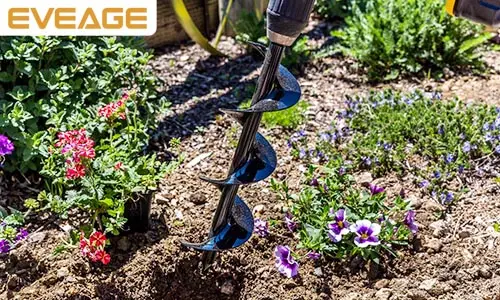Introduction
If you’ve ever wanted to plant trees or fence posts, then you probably already know that it’s not easy work. You’ll need an earth auger bit and an electric auger for this task, but which ones should you choose? While all types of augers can be used for planting post holes, there are differences between them that will influence your choice in one way or another. In this article we’ll discuss the three different types of augers: electric, manual and earth (non-electric) as well as how each works best for different situations. We’ll also go over some other factors to consider when choosing what type of drill bit to use on your project!
Its auger bit for 4×4 posts and trees is compatible with both 1/2 and 3/8 drills.
-
The auger bit is compatible with both 1/2 and 3/8 drill-rams.
-
The auger bit is 19 inches long.
-
The auger bit has a 3-inch diameter and 5/16 hex shaft (the size of your drill-ram will determine whether you need to buy a new shaft).
It has a 19-inch length with a 3-inch diameter and a 5/16-inch hex shaft, making it compatible with different sizes of auger bits.
When choosing the right drill for auger bits, you need to consider several factors. The first is the length of the bit and its diameter. A longer bit will hold up better in harder ground, but it may be more difficult to use because of its length. A shorter bit is easier to control than an overly long one, but it also has less leverage when it comes time to pierce through hard surfaces like concrete or stone.
The second factor you need to consider is the size of hex shaft that comes with each individual product (some only come with a ½ inch hex shaft). If you have different sized auger bits and want them all mounted on one drill, then this should be taken into account when selecting what kind of drill bit set would work best for your purposes.
This electric auger has six-inch long blades that can drill into both soft and hard surfaces.
The blades are the most important part of the auger. They need to be long enough to penetrate through hard ground, and sharp enough to cut through soft soil. The length of the auger’s blades should match your fence post diameter. For example, if you’re using 6″ x 6″ posts, you should use a 6″ auger with six-inch long blades.
The material used in making an auger’s blade is also important because it determines how easily it can cut through different types of dirt and rock without breaking or dulling prematurely. You’ll want one made from either steel or titanium—these materials are durable and strong but flexible enough not to break easily when drilling into tough materials like concrete or rock (which could happen if using other types of metals).
The number of blades on an electric fence post hole auger depends on how many holes you’re going to make at once; generally speaking though more blades mean faster work which means less time spent bending over grabbing tools off your truck bed! So if speed is important then consider getting an electric fence post hole machine that has four instead three!
It features a torque of 3,000 RPM, which is just enough power to churn up the soil without causing it to crack or break.
The force that is applied to the drill bit by its motor is called torque. Torque is measured in foot pounds, and it’s what causes your auger to spin around. If you don’t have enough torque for your purpose, then your auger will not get as much done as quickly as it should.
The size of your tractor or backhoe determines how powerful an auger you can use. You want an auger with just enough torque to get the job done without causing any damage to the soil in which you’re drilling holes for fence posts.
Hence, once you’ve chosen a good earth auger bit, the next step is to choose the right auger for post holes.
An auger is a tool that you can use to drill holes in the ground. You could choose to do this by hand, but it would take a very long time and be very labor-intensive. An auger will make the process much quicker and easier for you, plus it will help ensure that your hole is straight! The choice of an earth auger bit depends on what kind of soil you are drilling into. If you are working with soft soil, then a small size auger bit will work best; however if your job involves drilling into hard ground then you should use a larger diameter bit instead.
The best way to find one that is truly suitable for your needs is by choosing first the type and size of the drill bit you will use on your project.
First, you need to decide what type of auger bit you will use for your project. There are three basic types:
-
Hand-operated augers have a small handle on one end that’s turned by hand and a cutting head on the other end. These are generally used as drilling machines for softer materials like wood or plastic.
-
Powered augers have an electric motor attached to them, which makes them more efficient than manual ones at digging through harder objects such as soil or rocks. They’re also easier and safer to use since they don’t require any physical effort from the user besides turning on the machine itself (with some exceptions).
-
Cordless electric drills are designed specifically for drilling holes in hard surfaces like concrete walls—and they’re usually cheaper than corded models! However, these types aren’t ideal if you need something portable because they won’t work without being plugged into an outlet first; plus their batteries can run out quickly depending on how much pressure is applied during each cut cycle so keep this in mind before making your decision about buying one too quickly!
They’re also excellent for projects like planting trees or creating trenches in hard soil areas.
They’re also excellent for projects like planting trees or creating trenches in hard soil areas.
The auger bit is designed to create holes in the ground, which makes it a great tool for planting trees as well as digging trenches and creating underground drainage systems. It can even be used to dig holes for fence posts, although obviously this will take longer than using an electric post hole digger because of the amount of manual labor that needs to be done.
However, the type of soil you are working with will affect how well your auger bit performs: soft soils tend to make it difficult for the bit to penetrate deep enough into the ground before getting stuck (especially if there are rocks or roots present), while hard soils may not allow enough room between each turn of your drill motor so that your drill doesn’t get overheated from friction buildup between itself and whatever it’s trying—unsuccessfully—to penetrate through (like sand).
While all 3 types of augers might be usable in post drilling situations, they may not all be suitable for your project.
While all 3 types of augers might be usable in post drilling situations, they may not all be suitable for your project.
The most common type of auger is the 1/2-inch model. This size has been used for years and will generally be able to drill holes into most types of soil with ease. However, there are other options that you may want to consider before making a purchase.
Conclusion
Posthole augers can be used to drill holes for fence posts and other structures. They’re helpful for anyone looking to dig holes into soil or sand without having to use heavy equipment like a shovel or backhoe. The three types of augers are earth auger bits, electric augers, and manual hand drills. For example, if you want to drill through hard ground then an electric earth auger may work best as they have more power than manual hand drills or manual hammer drills



